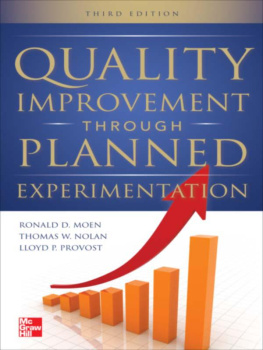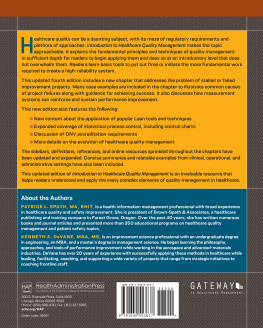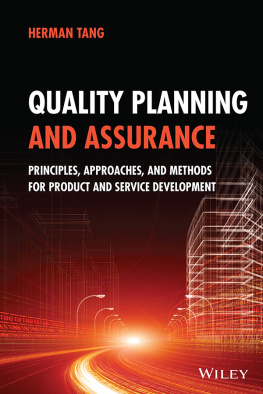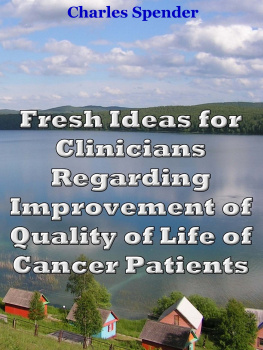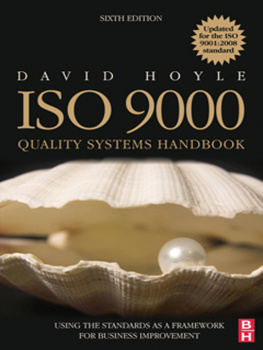Quality Improvement through Planned Experimentation
About the Authors
Ronald D. Moen is a statistician, consultant, and teacher to industry, government, health care, and education. He has M.S. degrees in mathematics and statistics. He has given presentations and consulted throughout the world. He is the author of several papers relating to improvement and coauthor of The Improvement Guide , 2nd edition (Jossey-Bass, 2009) and Quality Measurement (HCPro, 2003). He is the year 2002 recipient of the Deming Medal awarded by the American Society for Quality.
Thomas W. Nolan is a statistician, author, and consultant. Over the past 20 years, he has assisted organizations in many industries in the United States, Canada, and Europe, including chemical and automotive manufacturing, distribution, health care, and social services. Among his clients is a recipient of the Malcolm Baldrige National Quality Award. Nolan holds a doctorate in statistics from George Washington University. He has published articles in a variety of peer-reviewed journals as diverse as the Noise Control Engineering Journal and the British Medical Journal , and he is coauthor of The Improvement Guide , 2nd edition (Jossey-Bass, 2009). He was the year 2000 recipient of the Deming Medal and the 2009 recipient of the William Hunter Award from the American Society for Quality.
Lloyd P. Provost is a statistician, advisor, teacher, and author who helps organizations make improvements and foster continuous learning and improvement. His experience includes consulting in planned experimentation, measurement, planning, management systems, and other methods for improvement of quality and productivity. He has consulted with clients worldwide in a variety of industries, including health care, chemical, manufacturing, engineering, construction, automotive, electronics, food, transportation, professional services, retail, education, and government. Much of his current work is focused on health care improvement in developing countries. He has a B.S. in statistics from the University of Tennessee and an M.S. in statistics from the University of Florida. He is the author of several papers relating to improvement and coauthor of The Improvement Guide , 2nd edition (Jossey-Bass, 2009) and The Health Care Improvement Guide (Jossey-Bass, 2011). He was awarded the American Society for Qualitys Deming Medal in 2003.
Quality Improvement through Planned Experimentation
Third Edition
Ronald D. Moen
Thomas W. Nolan
Lloyd P. Provost
New York Chicago San Francisco
Lisbon London Madrid Mexico City
Milan New Delhi San Juan
Seoul Singapore Sydney Toronto
Copyright 2012 by The McGraw-Hill Companies, Inc. All rights reserved. Except as permitted under the United States Copyright Act of 1976, no part of this publication may be reproduced or distributed in any form or by any means, or stored in a database or retrieval system, without the prior written permission of the publisher.
ISBN: 978-0-07-175967-0
MHID: 0-07-175967-0
The material in this eBook also appears in the print version of this title: ISBN 978-0-07-175966-3, MHID 0-07-175966-2.
McGraw-Hill eBooks are available at special quantity discounts to use as premiums and sales promotions, or for use in corporate training programs. To contact a representative please e-mail us at .
All trademarks are trademarks of their respective owners. Rather than put a trademark symbol after every occurrence of a trademarked name, we use names in an editorial fashion only, and to the benefit of the trademark owner, with no intention of infringement of the trademark. Where such designations appear in this book, they have been printed with initial caps.
Information has been obtained by McGraw-Hill from sources believed to be reliable. However, because of the possibility of human or mechanical error by our sources, McGraw-Hill, or others, McGraw-Hill does not guarantee the accuracy, adequacy, or completeness of any information and is not responsible for any errors or omissions or the results obtained from the use of such information.
TERMS OF USE
This is a copyrighted work and The McGraw-Hill Companies, Inc. (McGraw-Hill) and its licensors reserve all rights in and to the work. Use of this work is subject to these terms. Except as permitted under the Copyright Act of 1976 and the right to store and retrieve one copy of the work, you may not decompile, disassemble, reverse engineer, reproduce, modify, create derivative works based upon, transmit, distribute, disseminate, sell, publish or sublicense the work or any part of it without McGraw-Hills prior consent. You may use the work for your own noncommercial and personal use; any other use of the work is strictly prohibited. Your right to use the work may be terminated if you fail to comply with these terms.
THE WORK IS PROVIDED AS IS. McGRAW-HILL AND ITS LICENSORS MAKE NO GUARANTEES OR WARRANTIES AS TO THE ACCURACY, ADEQUACY OR COMPLETENESS OF OR RESULTS TO BE OBTAINED FROM USING THE WORK, INCLUDING ANY INFORMATION THAT CAN BE ACCESSED THROUGH THE WORK VIA HYPERLINK OR OTHERWISE, AND EXPRESSLY DISCLAIM ANY WARRANTY, EXPRESS OR IMPLIED, INCLUDING BUT NOT LIMITED TO IMPLIED WARRANTIES OF MERCHANTABILITY OR FITNESS FOR A PARTICULAR PURPOSE. McGraw-Hill and its licensors do not warrant or guarantee that the functions contained in the work will meet your requirements or that its operation will be uninterrupted or error free. Neither McGraw-Hill nor its licensors shall be liable to you or anyone else for any inaccuracy, error or omission, regardless of cause, in the work or for any damages resulting therefrom. McGraw-Hill has no responsibility for the content of any information accessed through the work. Under no circumstances shall McGraw-Hill and/or its licensors be liable for any indirect, incidental, special, punitive, consequential or similar damages that result from the use of or inability to use the work, even if any of them has been advised of the possibility of such damages. This limitation of liability shall apply to any claim or cause whatsoever whether such claim or cause arises in contract, tort or otherwise.
To the Memory of W. Edwards Deming, 19001993
CONTENTS
FOREWORD
This book by Ronald D. Moen, Thomas W. Nolan, and Lloyd P. Provost breaks new ground in the problem of prediction based on data from comparisons of two or more methods or treatments, tests of materials, and experiments.
Why does anyone make a comparison of two methods, two treatments, two processes, or two materials? Why does anyone carry out a test or an experiment? The answer is to predictwhether one of the methods or materials tested will in the future, under a specified range of conditions, perform better than the other one.

